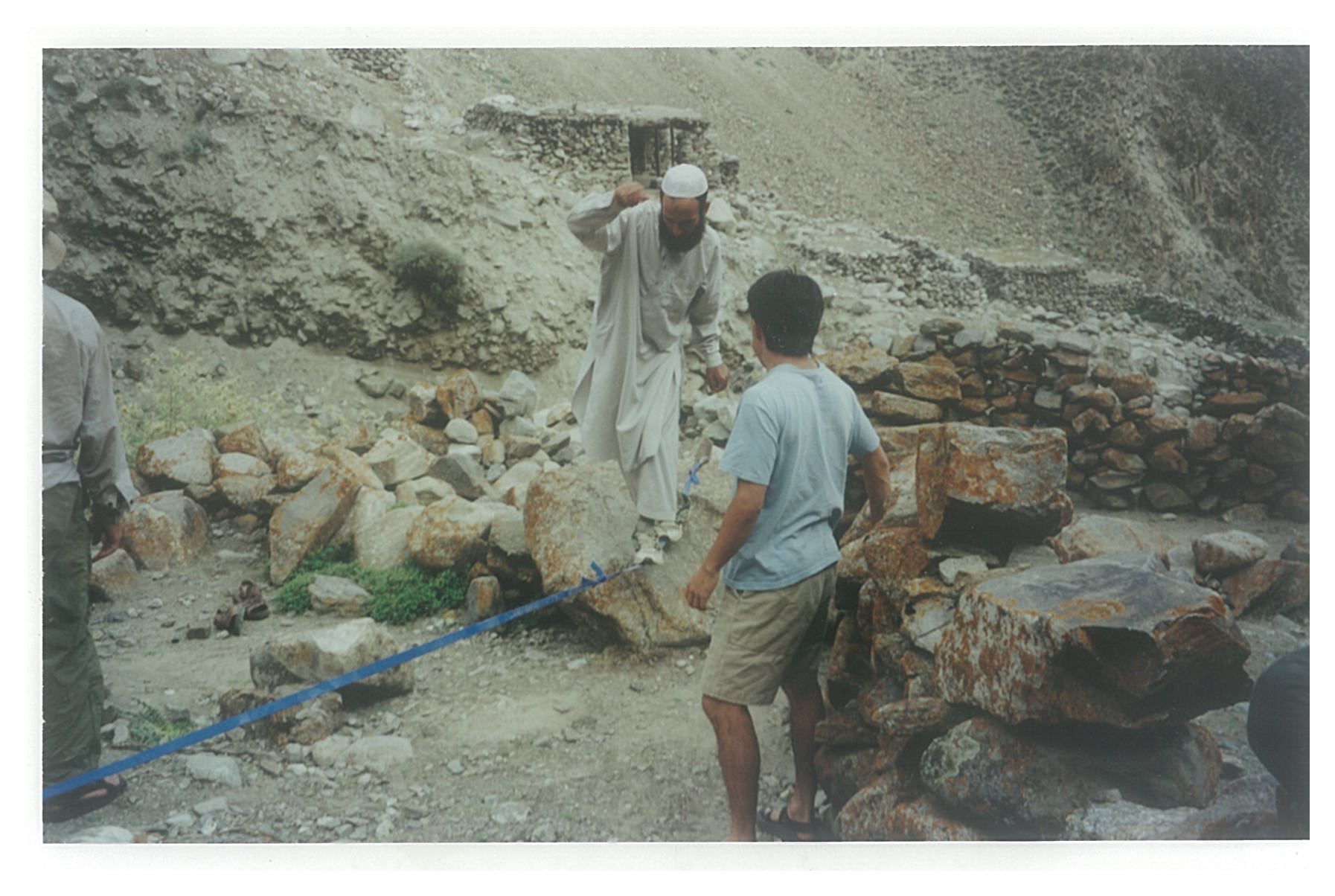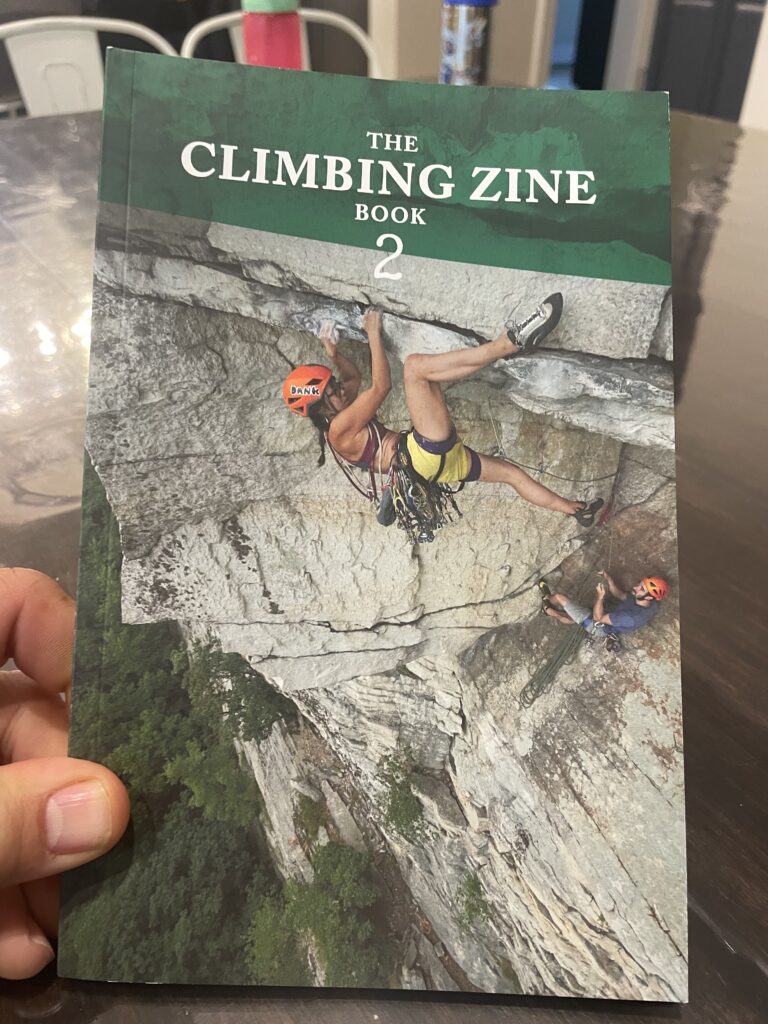This story starts and ends with a chicken.
On a bright morning in a high valley of the Hindu Kush, the doomed bird lay pinned atop a low stone wall that had been built by local goat herders. One sharp birdie eye looked up into the cloudless sky, the heavens a pale blue, the air crisp and thin. Warmed from night’s stillness by the brilliant sun, flies buzzed lazily over the rocky ground and surrounding talus.
Three men, Pakistanis from a nearby valley who made their living climbing local cliffs—and not, judging by their progress, dispatching chickens—surrounded the doomed bird. One held the body, another sawed at its neck with a dull butter knife, and the last stood by watching. Maybe he was offering advice. It was hard to know given the language barrier.
by Amanda Forrest
This story appears in The Climbing Zine Book 2, now available
Banner photo: Mayoor Khan walking the slackline coached by Hiroki Ide by the author.
Kestrel, Hiroki, and I, three of five US-based climbers on the expedition to northern Pakistan, stood off to the side shuffling our feet. Both our groups had been recruited by the expedition leader for a common goal: to search nearby cliff faces for an endangered, cave-dwelling flying squirrel. But after two weeks spent sharing a camp, our groups hadn’t yet interacted. The locals had kept to themselves, squatting on their heels at the edge of camp, carefully unfolding their prayer rugs and pressing their foreheads to the ground in devout silence, eating in a small group after we had finished with the cooks’ offerings. While we’d been climbing a variety of terrain near camp, from long alpine granite to low scruffy cliffs, they’d roved farther into the severely folded terrain, disappearing for days at a time.
Today though, our expedition leader, Peter, had suggested the groups climb together so that we could learn from them. The locals were the true experts, searching out the squirrels as a livelihood—more on that later—while we clearly didn’t know what we were doing. And so, Kestrel, Hiroki, and I had abandoned our breakfast of flatbreads, jam, and strong tea to approach their group and attempt an introduction.
None of us saw the chicken until we were within a few feet. The men surely must have noticed us, but their attention remained on the bird and their efforts to remove its head with the inadequate knife. After staring in awkward—and perhaps slightly horrified—silence for a couple minutes, we retreated. As far as first meetings with climbing partners go, I’d had better.
The journey to this point started back in Colorado in the spring of 2000.
When my friend Kath, an understated Brit who could run out meters and meters of brittle edge climbing above janky RPs, invited me on an expedition to seek the woolly flying squirrel, I assumed she was joking.
Some woolly flying squirrel facts: this endangered mammal lives only in cliffside caves in the lower reaches of the Hindu Kush and Karakoram. The heaviest glider in the world, it grows to be more than four feet long from nose to tail, with one-inch claws and a body roughly the size of a beagle. Launching from its home in the cave, it can glide the length of a football field. It subsists largely on pine needles.
But there’s more.
The squirrels’ excreta (that’s their poop and pee) congeals on the floor of their caves into a dark-brown resiny substance, not so different from hardened sap. It doesn’t smell like much of anything—except maybe pine needles. Called salajeet or shilajit, the stuff is a prized commodity. These days, you can buy it in capsule, powder, and liquid form online, though the vendors try to obfuscate the source—and who wouldn’t rather take an herbal supplement formed by years of water seeping through Himalayan soil and decaying plants than pill contents scraped from a matrix of congealed excrement? Or maybe there’s some truth to the vendors’ assertions—though they’re strongly refuted by local wisdom.
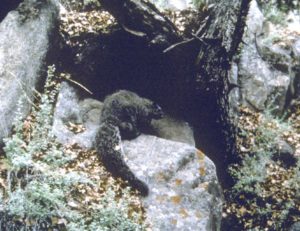
Regardless, the benefits are purportedly legion. Arthritis cure. Mood booster. Aphrodisiac. Really, the use depends on who you ask.
Kath and I had met for coffee in Boulder. I’d recently quit my software engineering job, broke off my engagement, and moved into my truck. My parents worried I was directionless. I thought I was just fine—if a little uncertain about what I wanted in life.
After sprinting through three years of college to a computer science degree, I’d worked at a couple companies, always trying to tweak the nine-to-five for a better climbing schedule. It wasn’t just that climbing provided the moving meditation I needed to stay even-keeled. It wasn’t just the vitamin D from days in the sun or the moments, on long free solos, where a single committing move could become the most transcendental experience of my life. School—and work—had always come easily for me…the intellectual parts, anyway. Socially and philosophically, not so much. I just couldn’t relate to my office mates and their trophy SUVs or their aspirations of a slow march to higher salaries that would buy more possessions but never more time.
Climbing was hard. It offered no upper bound in terms of challenge, particularly for someone like me who didn’t have the body type or natural aptitude. I was a fanatic, devoted to the ideal of unattainable perfection.
Even so, I couldn’t commit to an endless dirtbagging future. Maybe it was my parents’ influence, ingrained in me from early childhood, but the ethos of social responsibility put an endcap on my window of freedom. I’d saved enough money to buy health insurance for a while. My savings covered cheap food and gas. But eventually, I’d have to get another job, probably in software.
Once I realized Kath was serious, that this Pakistan expedition really did need climbers to explore untouched cliffs in search of monstrous squirrels and their doo-doo, I couldn’t get the idea out of my head. I’d probably never have another opportunity like this—especially one that arrived when I had no other obligations. I’d climbed some in Europe, and I’d always loved traveling. Somewhere in my back-brain, I imagined I might someday want to visit Pakistan to put up big routes, and this would be a good introduction to the area. And who wouldn’t want to search for flying, dog-sized rodents? I signed on and went back to climbing, waiting for August to arrive.
The major work of the venture was to survey the extent of the woolly’s habitat. Due to its endangered status, its diet of pine needles, and the lucrative trade in its poop, the Wildlife Conservation Society and Peter Zahler, the squirrels’ primary researcher, had spotted an opportunity to restrict logging in the squirrels’ home, a small set of patchy coniferous forests tucked into the mountainous terrain.
Our mission was clear: find the squirrels or their sign. But for the first two weeks in the mountains, we still had little idea how to accomplish it. After a terrifying journey up the Karakoram Highway, the only major road into the mountains, and a mix of pavement and sharply sloped landslide debris that tilted the minibus so far that I panicked and jumped out an uphill window, we encamped in a fold of the mountains above the Hunza Valley. We headed out in parties of two and three to search. The woolly is so little known, however, that we didn’t have much understanding of the conditions where it prefers to nest. Peter’s advice was sparse, largely due to his lack of climbing experience and the squirrel’s rarity—though he did suggest that if we were to capture one of these behemoth gliders, we should place it in our backpack and rappel.
He seemed to be serious.
Regardless, as a group, we were good at spotting striking ridgelines but crap at finding endangered mammals. We’d returned with plenty of baggies of random scat and stories of adventures up nice granite—aside from some bouldering near camp, most of our climbing had been up lower-fifth-class stone that reminded me of the High Sierra. Kath and Kestrel had discovered an emaciated and dehydrated cow and herded it back to water. But none of us had discovered the faintest sign of the woolly flying squirrel.
Peter had decided it was time to change our mode of operation. On the day we mistakenly interrupted the men during their efforts to behead the chicken, we had abandoned our first camp and moved into terrain nearer the previously verified habitat. The location put us within the presumed range, but more importantly, we were now going to learn from the experts.
Manwar Shed, Abdul Jabbar, and Mubeen were professional salajeet collectors. Hailing from a remote and conservative valley near the northern tribal areas of Pakistan—areas that were to become infamous in Western media as Taliban hotspots in the decade following the World Trade Center attacks—they smiled infrequently and spoke little, even—it seemed—to each other.
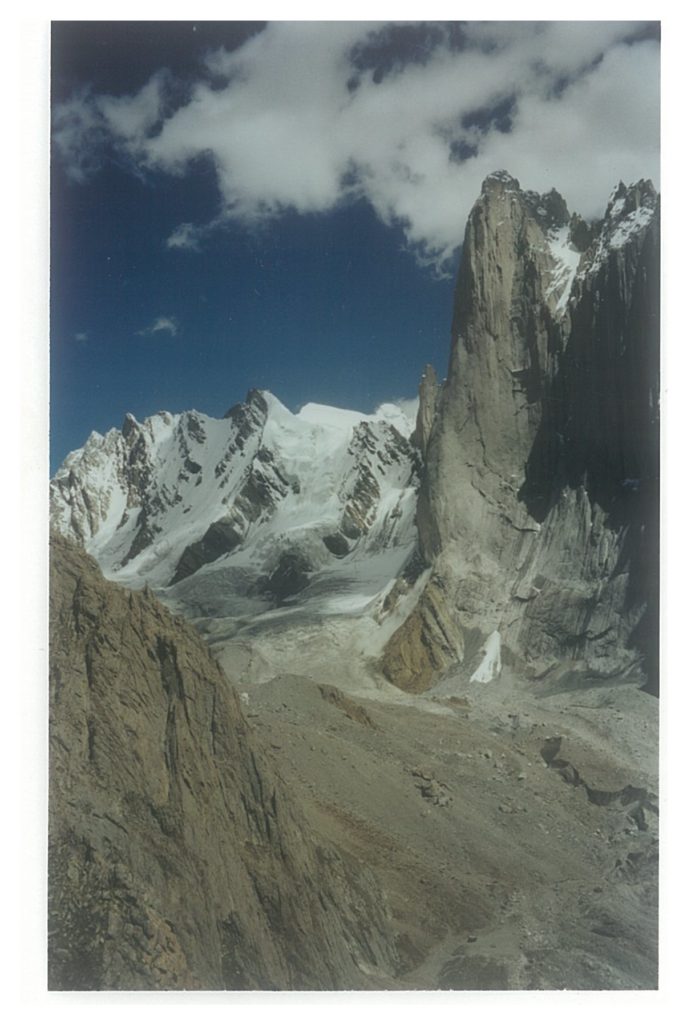
At our first camp, they’d often left for two or three days at a time on survey work. Wearing the traditional shalwar kameez, a knee-length tunic worn over loose trousers, and with only thin cardigan sweaters for warmth against the Himalayan nights, each man headed off alone. For supplies, they carried just a small stack of flatbreads wrapped in a scarf and a tin of snuff tucked into a pocket. Except when laid upon the stony earth during prayer time, their prayer rugs remained carefully folded and draped over a shoulder. They carried no water bottles; thirst meant walking to the nearest stream, often miles away from the ridge or escarpment they were investigating. Mountain sunshine and difficult conditions had etched deep lines in their faces, even in Mubeen’s, the youngest among them.
After breakfast, we—the Westerners—sorted our gear. Hardware jangled and bright ropes lay on goat-cropped grass before we stuffed our equipment into sturdy backpacks and filtered our day’s water from the stream. As we loaded up and prepared for the approach, the salajeet collectors appeared with a single coil of faded rope to share among the trio.
The hike to the nearest escarpment wasn’t far, around half-an-hour’s brisk walk, bringing us up to a flat bench on the valley floor. There, we dumped our backpacks while Mayoor Khan, our guide, liaison, and interpreter, built a fire and began heating tea water in a battered and blackened kettle.
The crag before us was nothing like the golden alpine granite we’d found at our previous camp. Scrappy and a sullen gray-black, the escarpment reminded me of many of the basement rock outcrops found near my hometown of Gunnison, Colorado. Ledges and caves turned the face into a broken mass around two pitches tall. Soapy and sloping, face holds shimmered with flecks of mica that also winked in the fine dust at the base.
As Mayoor labored over the fire and the tea, we wandered around the area. The salajeet collectors huddled together, examining the cliff face. None of them moved to offer instruction or to organize for the climb, and we weren’t sure how to ask. Maybe they were equally unsure. Finally, antsy, I laced up my climbing shoes and bouldered a bit. The rock smelled like home, dragging me back to high school and countless sketchy toprope setups and solos that failed to kill me during those formative summer vacations. Aside from a few trips from Boulder, where I went to college and then worked, to the Black Canyon, I hadn’t climbed much on this sort of stone over the past few years, and after a few weeks in a place that had been, at times, terrifying in its foreignness, I felt strangely grounded by the familiarity.
Shortly after I topped out on a tipped-back-but-ledgy hand crack and scrambled down the backside to rejoin the others for more tea, Mubeen approached the escarpment’s base. He shaded his eyes, looked up, and then shouted back to the other collectors. The conversation went back and forth for a minute or two, and then Mayoor abruptly told us they were ready to climb. We scarcely had time to set down our tea before Mubeen carefully laid his prayer rug over a boulder and started soloing up the initial slab.
He climbed in the same shoes he wore for the approach, a pair of clear-plastic flats that resembled the footwear we used to call jelly shoes during my junior high years in the late 1980s. With expert smearing, he arrived unscathed at a traversing ledge and briefly inspected the gentle overhang above. After testing a couple of the opening holds, Mubeen fired into the steep section, flagging his feet, moving artfully from hold to hold. His knee-length tunic hung behind him, out of the way of his movement. Pasting his jelly shoes onto smears on the down-sloping gneiss, he shifted his weight and cranked for a dead point to a jug. He mantled the jug, then fluidly crawled into the sloping dirt above.
The remaining two salajeet collectors turned to us. After a moment’s deliberation, Hiroki and I glanced at our mound of gear, then grabbed shoes and chalk bags, and headed for the base. The other two Pakistanis were still making their way over, having stopped to survey the cliff a last time, so we laced up
Hiroki and I tackled the slab one at a time and stopped at the ledge to assess. He traversed out first, brushing lichen and rock dust off the initial holds before committing. As he launched into the moves, Abdul Jabbar, the most senior of the locals, appeared on the slab
I stepped back to give the man space as he reached the ledge, then lifted the tatty coil of rope off his shoulder. Without warning, he threw the whole thing up and over Hiroki’s head. The rope missed its target, and rather than landing out of sight where—I assumed—Mubeen was waiting, it hit the wall above Hiroki and fell, smacking him on the way down. Fortunately, Hiroki is as solid a climber as he is humble, and the blow didn’t dislodge him. Abdul snatched the falling coil from the air and threw again. This time, the rope landed out of sight in a puff of dust. After a quick breath, Hiroki resumed climbing.
As he moved gracefully through the moves, a shadow sailed overhead. The loose end of the rope came looping out of the sky and whipped Hiroki on the back of the head. He pulled his body close to the rock, shoulders hunched, waiting for the next blow. But the rope now remained there, dangling silently in space.
Unsure what to do, Hiroki gave the line an experimental tug. It seemed secure, but he left it alone and pulled through the mantle to finish the steep section, leaving me and Abdul Jabbar alone on the ledge.
So many barriers separated us. Religion. Language. Gender. Technology and education. Unlike many Pakistanis living in the shadow of mountains that lure climbers from around the world, Abdul came from a valley where Westerners rarely—if ever—ventured. We were the first foreigners he had met and the first women he’d seen going about unveiled. But for all that, the silence wasn’t uncomfortable. A few times during the trip, I’d encountered open hostility. Inside a tea shop during a stopover on our journey into the mountains, the hatred directed toward our group—despite the headscarves and modest attire we wore while in the towns—had been so thick I could scarcely eat.
This was different. Abdul Jabbar patted the rock as if to encourage me. I nodded and set out.
Cautiously, I edged out over the slab and into the overhang. After a few moves, I called up to Hiroki.
“What’s with the rope?”
His response drifted down from above. “I think you’re supposed to grab it.”
“What’s it anchored to?”
“He’s holding it.”
“What’s he anchored to?”
“Nothing!”
I didn’t want to seem ungrateful. I also didn’t want to commit my weight to the rope. When possible, I let it slide through my hand while I kept fingertips latched onto solid rock. Every couple moves, I stopped and gave it a tug. Finally, I got a grip on the mantle jug and levered my head over the lip.
Mubeen—all 110 or 120 pounds of him—sat gripping the rope with both hands. His feet were plunged past the ankles into loose and sloping dirt. Hiroki perched nearby, choosing solid stone over the steep dust. For the first time since our team’s arrival in Pakistan, Mubeen and I made eye contact. Then he smiled. Then I smiled. Then all three of us started laughing.
After Abdul Jabbar and Manwar Shed arrived atop the overhang, we continued up the escarpment, a silent voyage following the crag’s weaknesses past crevices and crannies where we searched for signs of the squirrel. When we reached a short section of hand crack, we twisted our hands and feet into the fissure and, one after the other, clambered up. Turning sideways, we scuffled up an easy chimney. We found a cave with a cache of shiny salajeet—at last!—and Mubeen worked with a sharp rock, chiseling away until he broke off a small section.
Up top, the salajeet collectors contoured around to another section of the crag’s rim where Mubeen tied the sun-faded rope around his waist. The other two men took seats in the cliff-top rubble, planted their feet, and, hand over hand, lowered the youngest collector over the brink. After dropping ten or fifteen feet below the rim, Mubeen called for them to stop. The rope started rolling, then scraping back and forth over the edge.
Tiptoeing toward the lip, I glimpsed Mubeen running back and forth as he tried to pendulum to a promising cave. Meanwhile, red-faced, the other two men grunted and kept white-knuckled grips on the line. When I caught Hiroki’s eye, he shrugged, cringing. I considered grabbing the rope’s tail and adding a hip belay—maybe Hiroki was thinking the same thing. But before either of us could act, Mubeen shouted again. The belayers stood and started walking backward—sending my stomach cartwheeling at the thought that they might all go flying over the rim—and soon Mubeen appeared, breathless, with the rope cutting into his waist.
After the descent, we gathered for another cup of tea before one of the salajeet collectors pointed to a steep and switchbacking sheep trail that climbed through grass hummocks and around scattered stone outcrops to a rounded ridgetop. Mayoor translated: they suggested the ridge as our next target.
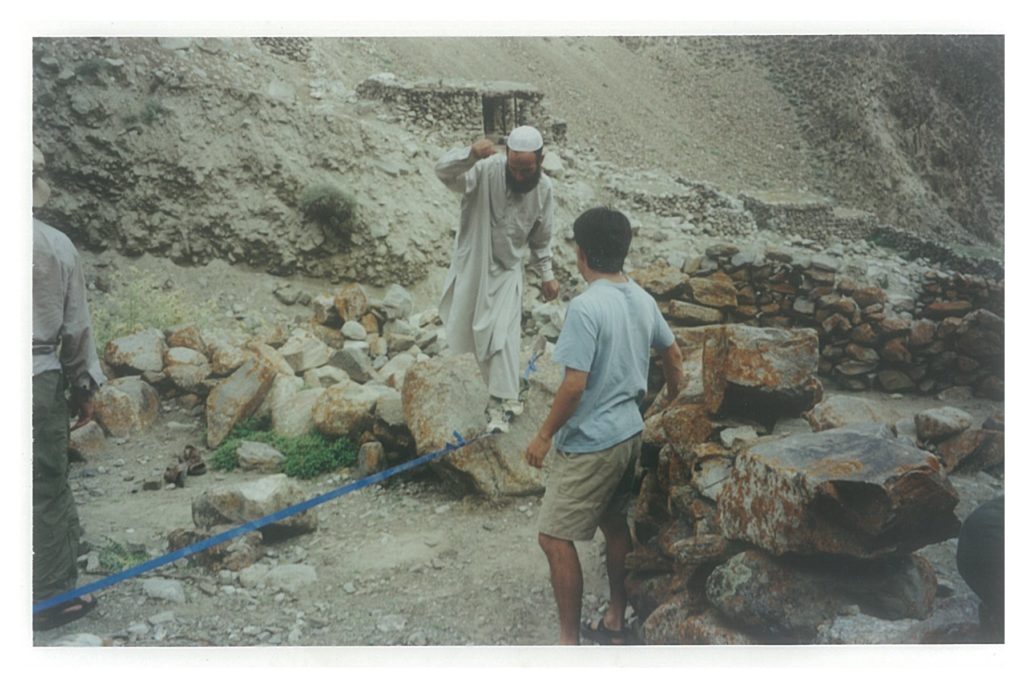
We set out together, all five climbers from the US, the salajeet collectors, and Mayoor with the teakettle—prefilled with water for the next brewing session. Dwarfed by the surrounding mountains, the ascent was one of those deceptive slogs that never seems to end. As the afternoon heat built, flies swarmed, landing in the corners of my eyes, tickling and biting where sweat trickled from my hairline. Partway through the ascent, we stopped for a drink. Dizzy from the heat and exertion, I sat on a hummock and fought the urge to sulk. There were clearly no cliffs or squirrel caves up here, so I failed to see the point in trudging on. Perhaps noticing my flagging spirits, Mubeen offered me a pinch of snuff. I declined.
After two thousand feet, as reckoned by an altimeter, we finally crested the ridge to a magical view. In the distance, across a deep gorge where the Gilgit River plunged toward its confluence with the Indus, the snowy giants of the Karakoram towered above cultivated fields and emerald apricot groves. Puffy clouds dotted the horizon while a fresh breeze from the high peaks of the Hindu Kush cooled the ridgetop.
We stopped on the ridge crest and sat in quiet awe. Only after a long rest did one of us ask why we’d made the climb.
Mayoor turned a warm smile on us. “They thought you would appreciate the view.”
On the way down, we stopped again for water, this time in higher spirits. Someone mentioned the chicken dinner that waited, and one of the salajeet collectors said something to Mayoor. Our guide turned to me. “He thinks you are probably able to eat the whole chicken after the climbs today.”
Everyone laughed at the joke that was also, obvious by the smiles, a compliment. And yes, I was very hungry.
I said the story starts and ends with a chicken, but that’s only partially true. Though, sadly, I must report it did not end with the discovery of a woolly flying squirrel either. To this day, I’ve seen only pictures and a short video clip of these Rodents of Unusual Size.
The story doesn’t really end with a chicken because, like with all intense experiences, the effects weren’t isolated to a single day (or year, or decade). The trip to Pakistan when I was a—turns out my parents were at least partially right about this—directionless twenty-five-year-old deeply affected the person I would become. The entire journey through the country still impacts me today.
When I first sat down to recount the hours spent climbing with the salajeet collectors, my first self-centered thought was to describe the moment where these men, raised to think that women should be subservient and modest, learned to accept me as a strong, independent individual. In a way, I viewed the day as a triumph of my way over theirs, enabled by the bond we shared in climbing. I thought I was already where I needed to be, a self-proclaimed liberal who already accepted the “other.”
Fortunately, I gave the situation more thought.
I may have already been willing to respect and engage with these men who were so different from me, but I wasn’t the bigger person. It’s no triumph of mine to know they confronted and challenged beliefs so strong that young men across the world kill and die for them every day. Mubeen, Abdul Jabbar, and Manwar Shed showed me the true meaning of accepting the other, and it’s likely I’ll never be able to match their incredible act of tolerance. But I will keep trying.
I flew home from Pakistan on September 11, 2000, exactly a year before the World Trade Center attacks. For those first weeks after the attacks, I felt the same outrage against extremism that—I imagine—most Americans did. I certainly never connected those hideous acts with the men and women I met in Pakistan, even the most conservative among them.
Then we went to war. After experiencing the terrain and the hardiness of those who lived there, I worried for our soldiers in Afghanistan. At the same time, I watched with horror as blanket anti-Muslim sentiment grew. I tried talking to people, coworkers at the job I took when my money ran out. Thinking I could change at least a few minds, I explained how people had invited us into their homes, how they’d put together feasts to welcome us, how Mayoor Khan had pulled me aside to say how much he respected the women on our expedition for being active and independent.
Often it felt like I was shouting into the wind, my voice torn away by a storm. In the early years of widespread social media, I tried a gentler written form of persuasion. We all know how well it works to convince people of anything over the internet. My experiences in Pakistan recur as themes in my short fiction, but at this point, I figure it’s as much for catharsis as anything.
Almost twenty years later, I can only speculate on how lives have changed in the areas we visited. In 2013, near where we stopped for tea and a meal and were confronted with such incredible hostility, a group of extremists stormed into basecamp at Nanga Parbat and massacred eleven people. Farther north, in the Hunza Valley where we were greeted with smiles and bottomless generosity, a massive landslide in 2010 blocked the river and created a lake that permanently submerged twelve miles of road and drowned whole villages.
Perhaps the hardest thing for me is the knowledge that many of the valleys in the remote region the salajeet collectors and Mayoor Khan called home fell under Taliban control. I don’t know and will probably never find out if they were affected. Mayoor had a college education. Maybe he got out. Maybe his education doomed him in the eyes of the fundamentalists. And what of the salajeet collectors? Were they recruited by the extremists? If so, do they think back to the day we climbed together and remember that they showed me how not to hate?
I hope so.
I will never forget the nearly incomprehensible distance the salajeet hunters crossed to share a rope (as it were) with me, nor will any amount of time erase my memories of Mubeen’s smile as he sat, anchored to nothing and risking his life to secure mine. We can all be better than the polarized, war-filled world outside our doors. I can be better than the person I often am: a deskbound writer who sits back and takes vicarious satisfaction in seeing people I disagree with skewered by streams of internet memes. We’ve just got this one world and one chance to care for each other. I want to be the person who plunges her feet into the dust and throws down a rope to someone who needs it, not the one who walks away because we disagree.
Amanda Forrest is responsible for keeping the coffee industry afloat. You’re welcome, growers. She also climbs and writes in Gunnison, Colorado, where she lives with her husband and nine-year-old daughter. She has the good fortune of making a living writing fantasy books as author Carrie Summers. Which is also cool because it’s like having a secret identity. Sort of.

